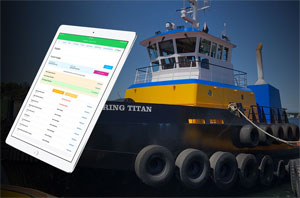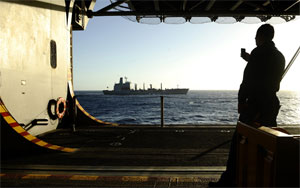While there may have been some lag in the adoption of mobile devices in the maritime world, that’s changing these days with the rapid evolution of mobile apps in communication, navigation and beyond. These new capabilities have helped improve life on the water and make it safer for mariners, and there’s a long and growing list of options.
In the past decade, the experience of people who work at desks has changed dramatically due to team communication applications like Slack. More recently, this digital transformation has spread to those who don’t sit at desks, especially workers in fields like transportation, construction, hospitality and manufacturing, said Bill Moore, CEO of the application startup Zello. Now, they are often making connections through applications — apps — that live on their mobile devices.
“Outdated and expensive radios are being replaced by more modern, reliable and affordable push-to-talk solutions” that have unlimited range and no interference, Moore said. He explained that mariners can use their favorite devices with Zello, which emulates push-to-talk walkie-talkies over cellphone networks and works on all Android, iOS and Windows devices. Zello users can also share photos, send text messages, track locations and trigger emergency alerts in critical situations. Ultimately, he said, the technology boosts collaboration and reduces “operational friction” while cutting costs.
“The biggest benefit of mobile apps is that the user does not have to be in front of their chartplotter, MFD or even in the wheelhouse to have access to the wealth of functionality available in today’s marine electronics,” said Jeff Robbins, CEO of Vesper Marine, a manufacturer of maritime safety products. Instead, captains and crew can have immediate access to navigation, weather, safety and communication data from their bunks or on deck.
In the recent past, Professional Mariner has highlighted some of the new developments in mobility:
 |
|
The iNavX app allows mariners to plot their position in real time using their smartphone’s built-in GPS. The app also provides access to navigation charts from a wide array of providers, and it can display instrument data when away from the wheelhouse. |
• Inmarsat Crew Xpress is a new service for crew within Fleet Xpress that includes the managed Wi-Fi solution Fleet Hotspot, a leased antenna, a business-use data package, automated billing, and usage revenue recovery to help ship managers invest in crew connectivity.
• iNavX, a mobile marine navigation application, is a hand-held chartplotting solution that allows users to find their location using the mobile device’s GPS, as well as plotting course, bearing and waypoints. The app includes access to a wide array of charts from leading providers including Navionics, NV Charts, Explorer and Waterway Guide.
• MobileOps, a cloud-based subscription solution, offers features that include vessel management, safety and training, jobs and dispatch, time cards and analytics. The MobileOps platform can be utilized on an app called Voyager that is available for computers and tablets.
• GTMaritime, a provider of maritime communication solutions, has launched SeaMail, an email product for smaller vessels such as barges, fishing boats, inland cargo carriers and leisure craft that only require a single email address. SeaMail is designed to be compatible with tablets and mobile devices, allowing crew to access business emails when and where required.
James Clark at NetBookNews, which bills itself as “the online authority on mobile computing,” illustrated the breadth and depth of the current field of offerings with two useful apps targeting the maritime environment:
• DNV GL’s Green Ship is an environmental calculator app that provides International Maritime Organization (IMO) emissions standards for carbon dioxide (CO2), nitrogen oxides (NOx), sulfur oxides (SOx) and ballast water for a given ship. As shipping regulations change and expand, the application can help evaluate the approximate environmental impact of a vessel.
• Hazcheck DGL Lite is a free database offering International Maritime Dangerous Goods (IMDG) Code information. The app has been updated to include Amendment 36-12 of the IMDG Code. It serves as an important reference tool for handling dangerous cargo at sea.
 |
|
MobileOps’ Voyager app is designed to operate out of cellular data range. Voyager allows mariners to perform operational tasks on MobileOps and sync when a connection is available. Safety manuals and other documents can be uploaded into MobileOps so crewmembers always have access to the latest information. |
|
Courtesy MobileOps |
Kseniia Kaplia, marketing manager at the Redwerk software development agency, provided three additional suggestions related to maritime mobility and communication:
• The International Transport Workers’ Federation offers an application called ITF Seafarers, a smartphone program that helps mariners access ship information, contact details for ITF inspections and branches, and ITF helplines.
• ITF’s Shore Leave app is designed to help mariners looking for reliable transport when in port. Once the app is downloaded, the contact details of seafarers’ centers all over the world are stored in the user’s smartphone for offline access.
• Equasis Mobile allows users to access an international database of ships and shipping companies. The application covers all merchant ships of more than 100 gross tons.
This growing field of mobility options means that mariners are no longer limited by a lack of connectivity and collaboration. They can now speak with each other at the push of a button anywhere with an Internet or data connection even hundreds of miles from shore.
As marine electronics evolve to add more capabilities to the hardware, integrating these advances into mobile devices is the next logical step, Robbins said. He said a perfect example is Vesper Marine’s smartAIS man-overboard alarm. If a crewmember is wearing an AIS transponder and ends up in the water, it immediately triggers an alarm on the company’s AIS hardware. This communicates, in turn, with the Vesper Marine mobile app, “so even if you are asleep off-watch, you will get a man-overboard notification that will relay the direction, distance and bearing of your crewmate,” he said.
All of Vesper’s smartAIS alarms, such as anchor and collision alarms, communicate with the company’s mobile app. “This powerful, lifesaving technology gives users valuable time to react to hazardous situations, which could mean the difference between life and death,” Robbins said.

